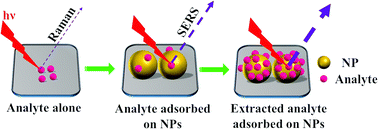Combining microextraction methods with surface-enhanced Raman spectroscopy towards more selective and sensitive analyte detection by plasmonic metal nanoparticles†
Abstract
Accuracy, selectivity, sensitivity, low cost, and rapid analysis are all challenging standards for analytical chemists. Gas chromatography (GC) and high-performance liquid chromatography (HPLC) techniques are known to meet these standards in addition to affording separation ability. However, these methods still have some limitations, including the long time needed for sample preparation for analyte detection. Surface-enhanced Raman spectroscopy (SERS) has been considered as an alternative technique for analyte analysis using nanoparticle substrates. However, concentrations of analytes lower than 10−6 M may not be efficiently detected by nanostructured materials without pre-concentration processes. Thus, in this mini review, we present the microextraction techniques that have been recently combined with SERS to enhance analyte signals using both liquid-phase and solid sorbents. Additional chemical modifications that have been utilized for SERS substrates are also highlighted. Finally, the structure of the analytes detected by SERS combined with the extraction methods and their detection limits are also presented.



 Please wait while we load your content...
Please wait while we load your content...